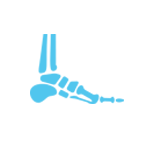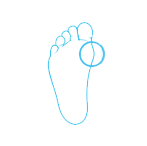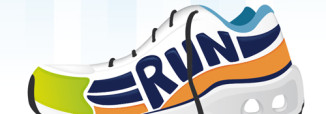Plantar Fasciitis
Plantar fasciitis is inflammation of a band of tissue on the bottom of your foot called the plantar fascia. It is triangular shaped attaching at the heel extending to the ball of your foot. It is the most common cause of heel pain.
Symptoms
- Intense stabbing pain on the bottom of the heel.
- Usually occurs after rest and is worse first thing in the morning.
- Will ease with activity but returns with prolonged standing.
Cause
Excessive tension is placed on the fascia causes it to become inflamed. Usually worse in the bottom of heel but can extend to arch area.
- More common in women than men.
- Most common between age of 40 -60.
- Exercise – treadmill on incline or running hills. Step aerobics.
- Faulty foot mechanics – more common in people with flat feet but can occur in people with high arches.
- Common in obese individuals.
- Common jobs that involve standing or walking long period of time. Used to be referred to as policeman’s heel.
- Improper shoe gear. Shoes that lack arch support. Thin soles. High heels shoes can cause shortening of Achilles and plantar fascia. Fine while you are in them but painful when not.
Complication
Ignoring plantar fasciitis may result in chronic heel pain which will alter the way you walk. As a result you can develop knee, hip and lower back pain.
Good news is that 90% of the patient with plantar fasciitis will improve with conservative treatment alone.
Plantar fasciitis treatment
Conservative treatment
90% of patients with plantar fasciitis will get better with conservative treatment.
- Proper shoe gear
- OTC innersoles
- Stretching exercise
- Contrast baths.
- Strapping taping foot.
- Physical therapy
- NSAIDS
- Night splints
- Orthotics
- Steroid injections
- Modify exercise program – low impact exercise.
- Maintain a healthy weight.
Surgical treatment
Is indicated when conservative therapy fails to alleviate the condition.
Endoscopic plantar fasciotomy is a minimally invasive procedure where tension on the plantar fascia is released by cutting the most medial band. The procedure is performed through two small incisions on either side of the heel. An endoscope is used to visualize the fascia and a small instrument is inserted to cut the plantar fascia. The post-operative course involves partial weight bearing for approximately 5 days followed by a return to sneakers.
*For products related to the treatment of plantar fasciitis we recommend footsupplystore.com
*To make an appointment with one of our physicians please call our office (numbers below) or fill out the contact form and we will contact you.











 114 West Mount Pleasant Ave
114 West Mount Pleasant Ave